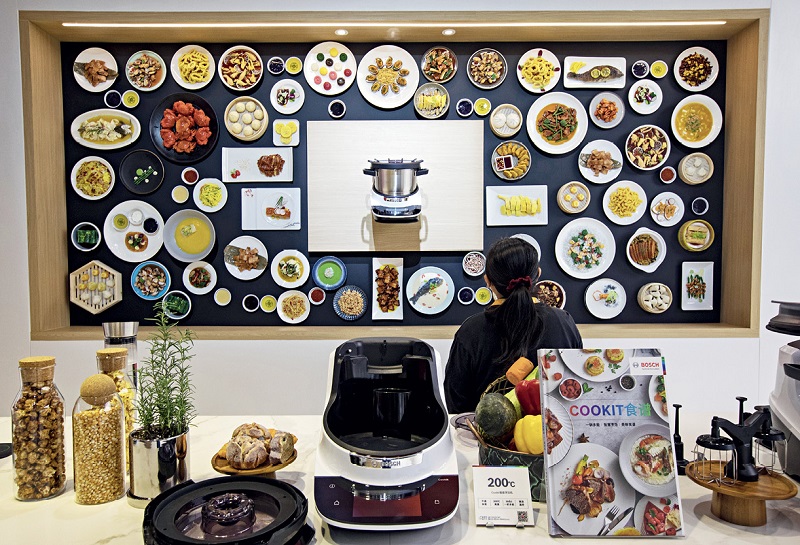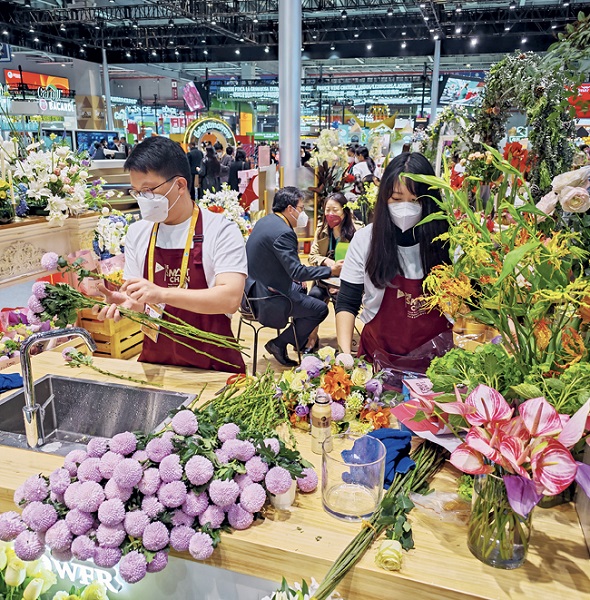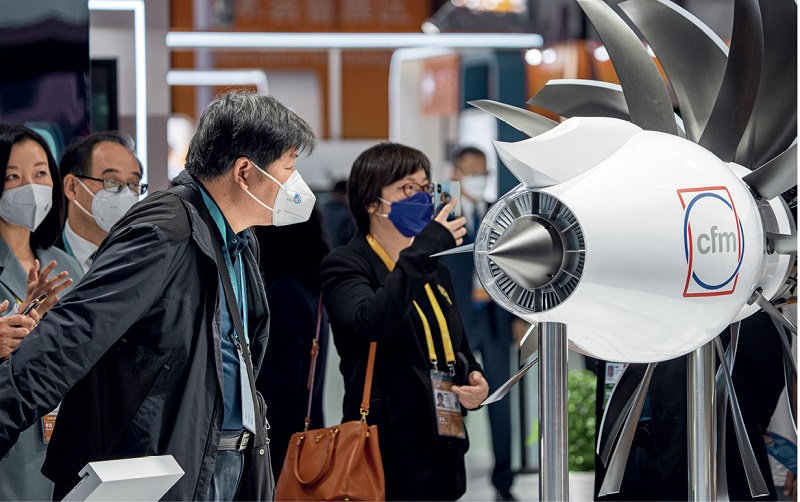
An exhibit of a smart cooker that can make 100 recipes by the German company Bosch at the 5th CIIE in Shanghai on November 8, 2022.
The fifth China International Import Expo (CIIE) reinforced its character as a key event to understand China’s continuous opening-up, a process emphasizing China’s development paradigm. Held after the 20th National Congress of the Communist Party of China (CPC), it upheld President Xi Jinping’s commitment at the congress that “we must keep to our path and not sway in our commitment. We must not return to the isolation and rigidity of the past, or veer off course by changing our nature or abandoning our system.”
This defines the successful path adopted by a country coming from the margins of power and influence several decades ago to the global forefront in the last decade, reflecting perseverance and self-confidence to achieve modernization. Its meaning goes beyond the national level.

Exhibitors busy making flower arrangements in the Food and Agricultural Products Exhibition Zone at the fifth CIIE in Shanghai on November 6, 2022.
Modernization and Resilience
China accounted for around one third of global growth in GDP during the last decade. Global companies need to have a presence in the Chinese market, which, even considering the many complexities, cannot be replaced in key fields. Furthermore, China remains central as potential global recession looms, described graphically by the 2022 IMF-World Bank Group Annual Meetings: “High food, fuel, and fertilizer prices rippling through the supply chains of an interconnected world, creating global disruptions and battering incomes and livelihoods.”
The Chinese high-standard opening-up concept is part of the solution. A continued effort to boost imports, exports and investments irrespective of geopolitical considerations, it is a contribution to the solution. Following the CPC National Congress, leaders from different continents visited Beijing prior to the CIIE, including Olaf Scholz, chancellor of Germany, one of the world’s key manufacturers and exporting powers. Scholz explained the trip saying: “China remains an important business and trading partner for Germany and Europe. We don’t want to decouple from it.”
The German delegation accompanying Scholz echoed the fact that German investments in China have rocketed. According to the Chinese Ministry of Commerce, they rose by 114.3 percent during the first nine months of 2022. They reflect German companies’ assumption of long-term stability and positive conditions for their businesses in the world’s second-largest consumer market.
The overall picture is both large-scale and consistent. According to data from the General Administration of Customs of China, China’s foreign trade in goods climbed 9.5 percent year on year to RMB 34.62 trillion (US $4.79 trillion) during the January-October period. In that period, the Association of Southeast Asian Nations was China’s largest trading partner, accounting for 15.2 percent of China’s total foreign trade. The European Union and the United States were China’s second-largest and third-largest trading partners respectively.

Visitors enjoying looking at the booth of the U.S. company General Electric (GE) at the Intelligent Industry & Information Technology Exhibition Zone of the fifth CIIE in Shanghai on November 5, 2022.
Three Columns of Opening-Up
Xi’s opening remarks at the fifth CIIE provided a window for the international community to understand both the expo as well as China’s trade and investment flows in the coming years. First of all, Beijing sees itself working with all countries and all parties to share the opportunities in its vast market. It will continue its efforts to cultivate a robust domestic market, upgrade the trade in goods, develop new mechanisms for trade in services, and import more quality products.
Silk Road e-commerce is an important part of the Belt and Road Initiative. To reach these goals, Silk Road e-commerce cooperation pilot zones will be established and innovation in trade and high-quality Belt and Road cooperation will be promoted. China’s trade with countries and regions participating in the Belt and Road Initiative has shown consistent year-on-year growth, with both imports and exports climbing over 20 percent.
According to Xi’s speech, China will expand opening-up regarding rules, regulations, management and standards. It has rolled out a new version of the catalogue of industries to encourage foreign investment, expanding the sectors for foreign investment, and will develop the national integrated demonstration zone for greater openness in the service sector. In the first week of November, the government announced that 29 more national demonstration zones for import promotion and innovation will be set up, bringing their total number to 43 across the country. Free trade areas will be upgraded. The Hainan Free Trade Port development project will be accelerated, boosting the southernmost coastal province as well as the national economy.
In addition, Xi promised China’s full and deep engagement in World Trade Organization (WTO) reform negotiations, and promoting trade and investment liberalization and facilitation. China will also enhance international macro-economic policy coordination to reinforce the new drivers for global growth. There is enough weight to think big. World Bank statistics have shown that China’s purchasing power parity in 2021 was US $27.3 trillion, ahead of the United States’ US $23 trillion.
Thinking big is also consistent with China’s intention to join the Comprehensive and Progressive Agreement for Trans-Pacific Partnership, a free trade agreement among 11 economies, and the Digital Economy Partnership Agreement, the world’s frst digital-only trade pact between Chile, New Zealand and Singapore that is open to all WTO members to expand the global networks of high-standard free trade areas. That move is coupled with the commitment to supporting other developing countries to grow faster. Relevant to both the notion of promoting free trade and supporting development is the increasing use of cross-border transactions in renminbi, which means increasing multilateralism.
Thus, it is not that China is “back” after the CPC Naional Congress and the CIIE. China has consistently been opening up to the outside world over the last four decades since it started the historic reform and opening-up drive. It is especially so in the last decade with the launch of the Belt and Road Initiative and through the CIIE, promoting globalization and trade liberalization as the foundations of global development. 
AUGUSTO SOTO is the director of the Dialogue with China Project.